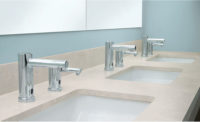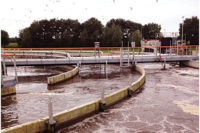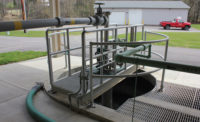Metering faucets are generally not the first thought that comes to mind when thinking about plumbing innovations. Still, these pieces have proven to be an innovation that has stood the test of time: the most effective way to reduce water use is by precisely controlling the amount of water flow and cycle time through self-closing valves.
It’s hard to imagine improving a device that’s one major purpose is to turn on and off the flow of water. Yet, over the years, a number of innovations have been made to the metering faucet, which can be manually or electronically operated. Metering faucets contribute to conservation simply by regulating the run time (cycle time), and thus controlling flow rate (gallons per minute).
Metering faucets are a remarkable piece of engineering and contain many overlooked features that, upon closer inspection, turned out to be innovative developments. Throughout their evolution, the improvements and innovations are not obvious because they are found within. That is, the innovation is in the technology and components that have occurred within the metering faucet.
A cartridge, for example, is at the heart of any faucet. It regulates the flow of water and is the most important component that affects overall performance. Cartridges were developed to maximize performance and make easy adjustments. Metering faucets also can contain preinstalled, free-spinning supply hoses that make installation easier. Many offer one-piece chrome-plated cast-spout bodies and vandal-proof components to minimize defacement. Because of the innovation, there are now many different types of cartridges used in metering faucets.
Learning these differences will help to not only understand the innovations involved, but also appreciate how these advancements improved the functionality of the metering faucet.
Manual metering
Beginning with the manual metering faucet, it is activated by pushing down on the top handle to activate the water. The water will run for a set time, determined by the setting on the mechanical cartridge and the amount of water pressure present.
The original manual metering device cycled the water by adjusting the timing mechanism. Essentially, the timing mechanism (or dashpot) has a hole that allows for precise control of the water that flows through it.
Adjustability was simply a matter of regulating water flow through a porous washer’s compression over the hole. The cartridge has a spring that is used to retract the valve. Water is controlled through compression of the washer. The more force compressed on the washer, the harder the water is to flow. Although the manufacturer sets the timing as a reference point, it can be adjusted.
Eventually, improvements were made using the same concept of leading water through a hole and a control pin where water bled through an opening with controlled tolerance. One innovation, for example, was a modular cartridge with a spring that made an actuator to go up and down. This placed the filter on the bottom of the cartridge for protection against line sediment.
Depressing the handle, the cartridge closes upon release or within a 2- to 30-second cycle time. Other innovations included an external timing nut for easy adjustment with no need for water shutoff and an added filter screen to protect against contaminants.
Electronic metering
Electronic faucets, which are really metering faucets, add another layer of control. Similar to manual metering, this duration of time can be through an outlet such as 0.5 gpm, 2 gpm and longer.
Faucets activated by an electronic sensor have a variety of designs differentiated by the type of sensor used and its field of sensitivity. These faucets are designed to activate when motion is detected by incorporating intelligent electronics that address false activations resulting from environmental surrounding influences. A sensor faucet can be adjusted to minimize water consumption by releasing flow only when hands are present in the water’s path — stopping immediately when they are removed.
Taking it a step further, combining low-flow outlets with precise electronic metering grants full control of water usage. Some electronic faucets can be programmed with handheld devices, thereby allowing maintenance to fine-tune performance to match application requirements. The faucet’s internal electronics don’t have to be physically touched to maximize water savings.
Keep in mind that water condition is a metering faucet’s biggest determinant to performance. Tolerances are impacted by water and continued innovation comes from understanding the end-user environments where the faucets perform such as sediment and chemically treated water.
Metering faucets evolve with environmental design tools
As energy conservation and green building continues to grow, so does the requirement for water-saving devices. When choosing a metered faucet, it is important to know whether it can meet your requirements. This choice will be dependent on which environmental design tool is being used.
Water-flow measurement data is vital information when using metering faucets and following water conservation guidelines such as EPAct of 1992, LEED 2009 or LEED v4 guidelines and other local plumbing codes. Thus, it is important to acknowledge the difference between run or cycle time (gal. per cycle) vs. flow rate (gal. per minute).
A cycle equals the number of seconds a faucet allows water to flow once activated:
Installed flow rate (gpc) = Flow rate (gpm) x (Duration (sec/cycle) / 60 sec).
However, cycle time as defined by the EPAct of 1992, referred to manual metering faucets, self-closing faucets and electronic faucets. Conversely, the criteria in some environmental design tools, such as LEED, use actual water volume consumed, which calculates flow rate, given as:
Flow rate (gpm) = (Installed flow rate (gpc) / Duration (sec/cycle)) x 60 seconds.
Therefore, knowing the gpc vs. gpm differences is imperative when dealing with environmental building design tools.
For example, if a building in New York City, which follows gpc criteria for metering faucets, specifies a metered faucet the criteria match is simple: confirm the metering faucet being specified matches the faucet guideline flow criteria.
However, if the same building also is striving for LEED certification, the faucet criteria to follow depend on which version of LEED is being followed. If following LEED 2009, then the same criterion applies. However, if following LEED v4, then closer attention to the details is needed.
Therefore, depending on which version of LEED the building is designed to meet, if any, the revisions to the Indoor Water Use Reduction portion garner closer review.
Particularly, metered faucets (manual and electronic) requirements have changed. In comparison to LEED 2009 where the baseline requirement was 0.25 gpc for metering faucets, metered faucets must follow the 0.5 gpm in LEED v4. This means it would take a 0.25-gpc metered faucet with a 30-second cycle to meet the 0.5 gpm LEED v4 baseline criteria. To achieve the 20% reduction prerequisite, a 0.25-gpc metered faucet would need to be adjusted to a 38-second cycle (achieving 0.38 gpm).
Another point of distinction is that LEED requires the use of WaterSense-labeled products where applicable. As of yet, WaterSense does not have a metered faucets category.
HELPFUL LINKS:









